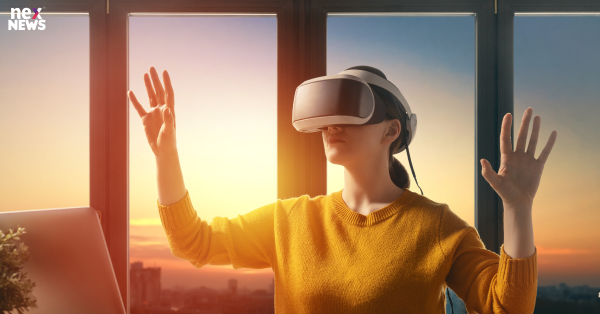Introduction
Augmented Reality (AR) and virtual reality (VR) are two cool technologies. They're like cousins but have some big differences. Both make things feel real, but they do it in their own special ways.
Here's the main difference: Augmented Reality adds cool virtual things to the real world you see, while Virtual Reality creates a whole new world that you can jump into and explore.
Think of it like this: virtual reality is like stepping into a fantastic, made-up world, while augmented reality is like having awesome digital extras added to your regular world. They both make experiences exciting in their own unique styles.
Understanding Augmented Reality
Augmented reality is a fancy term for technology that puts computer-made pictures, details, and info into the real world using a device. This tech lets people play around with computer-made stuff while being in the real world.
It's like adding layers of digital and visual stuff to what's really around us. Imagine using your phone's camera and screen to see extra things on top of what's there in reality. You're still in the real world, but your screen shows you more information that blends with what you see.
For instance, you could look at a restaurant menu using augmented reality, just by focusing on the menu. Or, if you point your phone's camera at a piece of art, you might see extra info about it. You could even play games, like a treasure hunt, anywhere you like.
To sum it up, augmented reality has many uses. It lets you see more details about where you are or play with virtual stuff in the real world. How? Well, the device scans images, things, surfaces, or landscapes, and then you can have augmented reality adventures based on what it recognizes.
Applications and Examples
Augmented reality is a cool technology that puts digital stuff on top of the real world, making a mix of what's really there and what's computer-made. It's not just fancy tech; it's actually pretty useful in different areas. Let's check out some examples.
Advertising and Marketing
Companies use augmented reality in ads to make fun and immersive experiences for people. Imagine playing a game on your phone for a new burger and, at the same time, the burger company learns what you like. That's what Goiko did for their new burger promotion.
E-commerce and Retail
When you want to buy something online, augmented reality helps you see how it looks before buying. This way, you can decide if you really want it, and it helps companies because people return stuff less often.
Tourism and Culture
If you're touring a museum, augmented reality gives you extra info about art or history. Just point your phone at a painting and boom, you get more details. It makes learning fun for tourists.
Education
In class, teachers use augmented reality to show 3D models of things. It's like having a virtual zoo or museum right in your classroom. Makes learning way cooler!
Medicine
Doctors use augmented reality to be super precise in surgery and training. They overlay important info on patients in real-time, like X-rays, to understand things better. This tech helps them do a great job.
Architecture, Construction, and Design
In building and design work, augmented reality is like a magic tool. Architects can use it to see how a building will look in real life before it's even built. It's like trying out clothes before buying them but for buildings!
What's Virtual Reality?
Virtual reality is like stepping into a make-believe world using special gadgets. These gadgets have screens and sensors that help you feel like you're really in a different place. You can play games, watch cool movies, or even practice things in this pretend world. People use virtual reality for fun stuff like games and movies, but also for learning and practicing things in a safe, made-up space.
Virtual reality makes a whole new world that you can explore using things like headsets, headphones, or VR glasses. Inside this made-up world, you can touch and play with things that aren't real. It's like going on an adventure without leaving your room! People use it for fun things like games, and also for serious stuff like learning and practicing in a safe, pretend place.
Applications and Examples
Virtual reality is a cool tech that makes a pretend 3D world you can experience using special glasses or goggles. Let's dive into some ways we use this awesome technology:
Learning and Training Adventures
Picture this: using virtual reality to learn stuff. It happens! In schools and training programs, we can pretend to be in real-life situations without any real danger. Like doctors practicing surgeries without actually cutting someone.
Super Fun Entertainment
Virtual reality isn't just for learning; it's also for having a blast! Imagine playing video games where you feel like you're in the game, not just staring at a screen. Or watching movies and concerts like you're right there in the action.
Therapy
Guess what? Virtual reality can help people feel better, both mentally and physically. For instance, if someone is afraid of something, they can use virtual reality to face their fears in a safe way. It's like magic therapy through cool tech!
Virtual World Travel
Have you ever wished you could explore far-off places without leaving your room? Virtual reality makes it happen. You can "travel" to cities or places that might be too risky in real life. It's like going on an adventure without packing a suitcase.
Exercise
Now, here's a fun twist! Virtual reality isn't just for your brain; it's for your body too. You can exercise in a made-up world that makes working out more exciting. Imagine doing jumping jacks in a virtual jungle – how cool is that?
Market Trends & What's Coming Next
Both augmented reality and virtual reality are new technologies with a lot of potential and a big demand in the market. The market for these technologies has been growing a lot recently, and it's going to keep growing in the future.
A report from MarketsandMarkets says that by 2026, the AR and VR market could be worth $117.4 billion. That's a big number, and it's expected to grow by 34.1% every year from 2021 to 2026. The report also says that the augmented reality market by itself is predicted to reach $55.8 billion by 2025, growing at a rate of 40.29% every year from 2020 to 2025.
People are using augmented reality and virtual reality more and more in different industries. This helps make the user experience better and makes interacting with the digital world more fun. Also, because of the COVID-19 pandemic, businesses have had to find new ways to connect with their customers from a distance. That's where these technologies come in handy.
In a nutshell, we can expect more cool gadgets and technologies in the future to make our experiences even better. These technologies will become a normal part of our daily lives and change the way we watch and interact with things in both the digital and real world.

